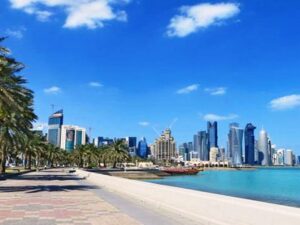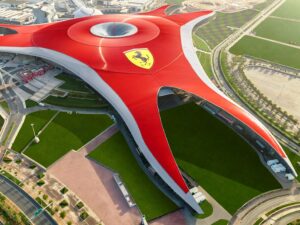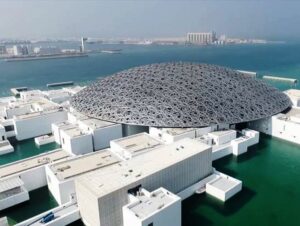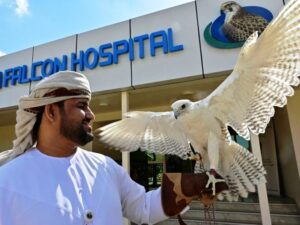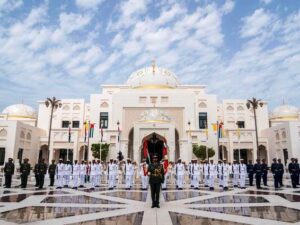Archive for August, 2022
» posted on Thursday, August 11th, 2022 by Linda Lou Burton
But Who’s Counting?
Originally published August 7, 2020 by Linda Lou Burton posting about Cairo, Egypt from Little Rock, Arkansas – There are 81 cities in the world with a population over 5 million. Only 9 of those are in the US. I’ve been to them, and I’ve been to 6 of the ones outside the US. But I’ve never been to a city as large as Cairo. About 20,790,000 people live in the metro area, give or take a few. And over 9 million of those live downtown. Am I daunted by that? A little.
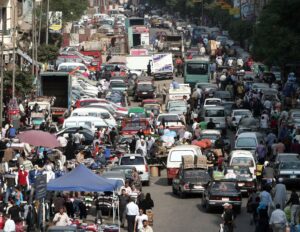 The negatives were considered when I plotted out my time here. Air pollution is serious. There are 4.5 million cars on Cairo streets, most of them old. And there are many unregistered lead and copper smelters in Cairo, major polluters. Because of the lack of rain, plus the city’s layout of tall buildings and narrow streets, which create a bowl effect, the dispersion factor is poor. A permanent haze over the city with particulate matter three times normal causes serious respiratory diseases and eye irritations; it is estimated that between 10 to 25 thousand deaths related to air pollution occur in a year; tourists need to take extra care. Another caution: Cairo is considered one of the most dangerous cities in the world for women; 99% of women living here report they have been sexually harassed, though new national laws define and criminalize those behaviors.
The negatives were considered when I plotted out my time here. Air pollution is serious. There are 4.5 million cars on Cairo streets, most of them old. And there are many unregistered lead and copper smelters in Cairo, major polluters. Because of the lack of rain, plus the city’s layout of tall buildings and narrow streets, which create a bowl effect, the dispersion factor is poor. A permanent haze over the city with particulate matter three times normal causes serious respiratory diseases and eye irritations; it is estimated that between 10 to 25 thousand deaths related to air pollution occur in a year; tourists need to take extra care. Another caution: Cairo is considered one of the most dangerous cities in the world for women; 99% of women living here report they have been sexually harassed, though new national laws define and criminalize those behaviors.
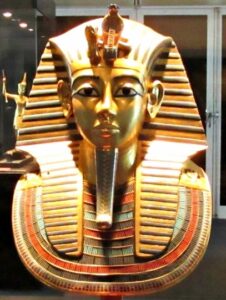 Still, I am here, and I always focus on the positives. On the plus side of things, this city is bubbling over with history. Founded in 969, it’s pretty young when you consider that just 9 miles to the west sits the Sphinx, which some Egyptologists believe is at least 4,500 years old. And then there’s all that King Tut stuff here in Cairo museums, remnants of ancient civilizations. But I didn’t come for that. I came for two specific reasons: to see the Great Pyramid of Giza, one of the constructed Wonders of the World. And I came because of the River Nile. Of course, Cairo does happen to be a capital city as well! And I am counting.
Still, I am here, and I always focus on the positives. On the plus side of things, this city is bubbling over with history. Founded in 969, it’s pretty young when you consider that just 9 miles to the west sits the Sphinx, which some Egyptologists believe is at least 4,500 years old. And then there’s all that King Tut stuff here in Cairo museums, remnants of ancient civilizations. But I didn’t come for that. I came for two specific reasons: to see the Great Pyramid of Giza, one of the constructed Wonders of the World. And I came because of the River Nile. Of course, Cairo does happen to be a capital city as well! And I am counting.
Cairo sits mostly on the east bank of the Nile, and almost at the end of the river’s 4,160-mile journey from south of the equator to the Mediterranean Sea. Yes, it flows northward, and its 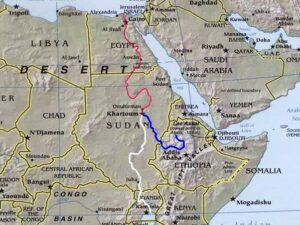 basin includes parts of Tanzania, Burundi, Rwanda, the Democratic Republic of the Congo, Kenya, Uganda, Ethiopia, Sudan, and the cultivated part of Egypt. I’ll go with what most geographers say about its beginnings; the Blue Nile comes from Lake Tana in Ethiopia and the White Nile from Lake Victoria in Tanzania; they converge at Khartoum in the Sudan
basin includes parts of Tanzania, Burundi, Rwanda, the Democratic Republic of the Congo, Kenya, Uganda, Ethiopia, Sudan, and the cultivated part of Egypt. I’ll go with what most geographers say about its beginnings; the Blue Nile comes from Lake Tana in Ethiopia and the White Nile from Lake Victoria in Tanzania; they converge at Khartoum in the Sudan 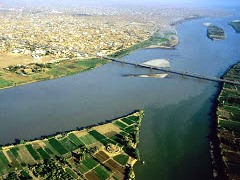 where the waterway becomes the “Nile,” which in ancient Egyptian means “great river.” It winds and twists its way into Egypt where it meets the Aswan Dam, built in the 1960s; an embankment dam that has produced both positive and negative benefits, as any effort to control nature generally does. Massive amounts of electricity, increasing water resources, and flood control – good; decrease in the fertility of agricultural lands in the delta – bad. Those floods deposited millions of tons of silt each year, nature’s way of fertilizing without chemicals. The building of the dam also impacted the ancient cities and temples along the river; controversy there.
where the waterway becomes the “Nile,” which in ancient Egyptian means “great river.” It winds and twists its way into Egypt where it meets the Aswan Dam, built in the 1960s; an embankment dam that has produced both positive and negative benefits, as any effort to control nature generally does. Massive amounts of electricity, increasing water resources, and flood control – good; decrease in the fertility of agricultural lands in the delta – bad. Those floods deposited millions of tons of silt each year, nature’s way of fertilizing without chemicals. The building of the dam also impacted the ancient cities and temples along the river; controversy there.
So how could I get myself on this river? There are many cruises available; most are south of Cairo, on luxury boats with stops allowing “visits to ancient civilizations” while carefully  avoiding the Nile crocodile. A 12-day Viking cruise beginning and ending in Cairo sounded enticing. Let your imagination soar as your ship meanders through panoramic desertscapes, fertile farmlands, colorful villages and UNESCO World Heritage Sites that preserve the ancient glory of Egypt’s greatest temples, palaces and tombs. Included excursions in every port reveal highlights like these:
avoiding the Nile crocodile. A 12-day Viking cruise beginning and ending in Cairo sounded enticing. Let your imagination soar as your ship meanders through panoramic desertscapes, fertile farmlands, colorful villages and UNESCO World Heritage Sites that preserve the ancient glory of Egypt’s greatest temples, palaces and tombs. Included excursions in every port reveal highlights like these:
- Luxor’s Karnak Temple complex
- The Necropolis of Thebes, Egypt’s largest repository of pharaonic tombs
- Luxor Temple, with its sphinx-lined avenue
- Privileged Access to the tomb of Nefertari in the Valley of the Queens
- The graceful temple of Hatshepsut, Egypt’s only female pharaoh
- The temple of Hathor at Dendera
- The romantic, waterbound Temple of Isis at Philae
- Horse-drawn calèche tour to Edfu’s Temple of Horus
I didn’t have time for all of that! I just wanted to cruise the Nile.
 So I settled for an evening dinner cruise in Cairo with pickup from my hotel. Itinerary, their translation: Sun Pyramids Tours will pick you up from your hotel and transfer to Nile Pharaoh Dinner Cruise dock. Embark the famous Cairiane cruises which resembles a pharaonich barge with tribute to ancient Egyptian god Hathor. From the deck you can take panoramic views of Cairo skyline at the evening. Enjoy a sumptuous international buffet dinner with variety of Egyptian and international cuisine and desserts. Live performances of belly dance, and tanura the sufi meditation whirling dervish shows will take place while you are having dinner. After dinner you can again rise to the deck to enjoy the air breeze of the Nile and take in the marvelous glittering sights of Cairo as the boat returns back to the dock. Upon arrival you will be transferred back to your hotel.
So I settled for an evening dinner cruise in Cairo with pickup from my hotel. Itinerary, their translation: Sun Pyramids Tours will pick you up from your hotel and transfer to Nile Pharaoh Dinner Cruise dock. Embark the famous Cairiane cruises which resembles a pharaonich barge with tribute to ancient Egyptian god Hathor. From the deck you can take panoramic views of Cairo skyline at the evening. Enjoy a sumptuous international buffet dinner with variety of Egyptian and international cuisine and desserts. Live performances of belly dance, and tanura the sufi meditation whirling dervish shows will take place while you are having dinner. After dinner you can again rise to the deck to enjoy the air breeze of the Nile and take in the marvelous glittering sights of Cairo as the boat returns back to the dock. Upon arrival you will be transferred back to your hotel.
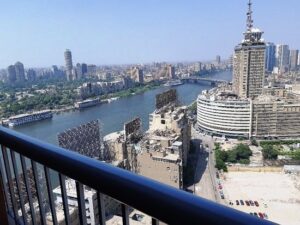 I expect my head will be whirling like that dervish by the time I get to bed. But my room does overlook the Nile; and my view stretches far across this busy whirling city that has 4.5 million horn-honking cars. There may be too much pollution and too much commotion, but tomorrow I have an entire day to hang out with the Sphinx and touch the Pyramid of Giza. And I will have cruised the Nile, just think how much of Africa its waters have touched!
I expect my head will be whirling like that dervish by the time I get to bed. But my room does overlook the Nile; and my view stretches far across this busy whirling city that has 4.5 million horn-honking cars. There may be too much pollution and too much commotion, but tomorrow I have an entire day to hang out with the Sphinx and touch the Pyramid of Giza. And I will have cruised the Nile, just think how much of Africa its waters have touched!
Pluses, and minuses, but who’s counting?
» posted on Wednesday, August 10th, 2022 by Linda Lou Burton
Come Fly With Me
Originally published August 7, 2020 by Linda Lou Burton posting about Cairo, Egypt from Little Rock, Arkansas – Hurry, hurry, zip the suitcase, check out. Today’s flight isn’t too bad, just a few hours. I’m flying Ethiad again, I didn’t realize when I booked my flight that they are headquartered in Abu Dhabi, right by the International Airport. It’s 1,480 miles from there to Cairo International (CAI) and then another 13 miles to my hotel, the Ramses Hilton. I’ll be flying over Qatar, Saudi Arabia, and maybe Jordan and the Suez Canal.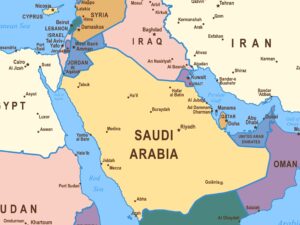
I’m not leaving Abu Dhabi till 2:30 this afternoon, so I have time to do just a little more looking around this blindingly bright city that sits beside this incredibly blue water. As usual, I hate to leave where I am. I wish I had another week, at least.
But guess what. I’m booked for an evening dinner cruise on the Nile tonight. That’s the longest river in Africa, remember?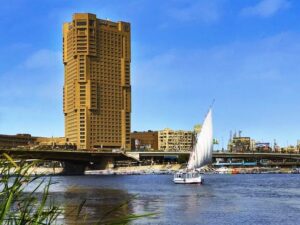
» posted on Tuesday, August 9th, 2022 by Linda Lou Burton
Just Wanna Have Fun
 Originally published August 6, 2020 by Linda Lou Burton posting about Abu Dhabi, United Arab Emirates from Little Rock, Arkansas – What do you do for fun in Abu Dhabi? That was my question. I’ve seen the Grand Mosque where people worship, the Presidential Palace where government happens, and the skyscrapers where people work, and live. Now what? There are bus, boat, and seaplane tours that show you around; specific trips such as “island getaways,” or “desert dune rides.” Abu Dhabi is big on shopping, so lots of fancy malls. But first, I checked out the food scene.
Originally published August 6, 2020 by Linda Lou Burton posting about Abu Dhabi, United Arab Emirates from Little Rock, Arkansas – What do you do for fun in Abu Dhabi? That was my question. I’ve seen the Grand Mosque where people worship, the Presidential Palace where government happens, and the skyscrapers where people work, and live. Now what? There are bus, boat, and seaplane tours that show you around; specific trips such as “island getaways,” or “desert dune rides.” Abu Dhabi is big on shopping, so lots of fancy malls. But first, I checked out the food scene.
Food
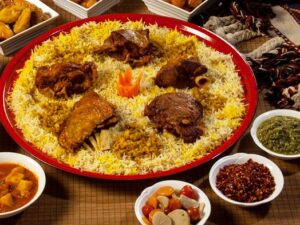 I didn’t know what foods to expect in the United Arab Emirates; here is what I found: restaurants seem to cover all the bases – Chinese, Japanese, Indian, Italian, Peruvian, and even traditional Emirati! Meat, fish, and rice are staples of the Emirati cuisine; lamb and mutton are more favored than goat, beef and camel. Dates are generally part of a meal; coffee and tea are supplemented with cardamom, saffron, or mint to give it a distinct flavor. I’m familiar with hummus and kebabs, but some menu items are new to me, such as machboos. That is a rice dish, with onions, spices, meat, and dried lemon peel; simmered till tender, a must do. Harees is one of the most popular traditional foods in the Emirati kitchen, especially during important family
I didn’t know what foods to expect in the United Arab Emirates; here is what I found: restaurants seem to cover all the bases – Chinese, Japanese, Indian, Italian, Peruvian, and even traditional Emirati! Meat, fish, and rice are staples of the Emirati cuisine; lamb and mutton are more favored than goat, beef and camel. Dates are generally part of a meal; coffee and tea are supplemented with cardamom, saffron, or mint to give it a distinct flavor. I’m familiar with hummus and kebabs, but some menu items are new to me, such as machboos. That is a rice dish, with onions, spices, meat, and dried lemon peel; simmered till tender, a must do. Harees is one of the most popular traditional foods in the Emirati kitchen, especially during important family  gatherings and special holidays. Put meat and wheat together in a “mash pan” with water and salt and cook for a long time (at least four hours), stirring with a wooden spoon called a “masad masr.” Sprinkle chopped fried onions on top. Eat! For breakfast, it’s balaleet, vermicelli sweetened with cardamom, saffron, and rose water, then topped with a thin egg omelet; or have a chebab, a pancake; or khameer, date-sweetened bread.
gatherings and special holidays. Put meat and wheat together in a “mash pan” with water and salt and cook for a long time (at least four hours), stirring with a wooden spoon called a “masad masr.” Sprinkle chopped fried onions on top. Eat! For breakfast, it’s balaleet, vermicelli sweetened with cardamom, saffron, and rose water, then topped with a thin egg omelet; or have a chebab, a pancake; or khameer, date-sweetened bread.
 A restaurant on the mainland and one on the beach caught my eye: Meylas – “childhood recipes crafted by Emirati mothers and grandmothers, locally sourced ingredients; décor offers a nostalgic look at the time of the Bedouins; gift items by Emirati artists for sale, and delicacies to take home, dates to mango pickles.” Mezlai – “local dishes, traditional recipes featuring staples from Emirati cuisine such as camel, dates, rosewater; furnished with Bedouin emblems, dallah tapestries, reminiscent of a Bedouin tent; a luxury setting in the Emirates Palace Hotel on the Corniche.
A restaurant on the mainland and one on the beach caught my eye: Meylas – “childhood recipes crafted by Emirati mothers and grandmothers, locally sourced ingredients; décor offers a nostalgic look at the time of the Bedouins; gift items by Emirati artists for sale, and delicacies to take home, dates to mango pickles.” Mezlai – “local dishes, traditional recipes featuring staples from Emirati cuisine such as camel, dates, rosewater; furnished with Bedouin emblems, dallah tapestries, reminiscent of a Bedouin tent; a luxury setting in the Emirates Palace Hotel on the Corniche.
The Corniche is a curving street along the edge of the beach, and what a street it is. Walking paths, cycle paths, fountains, parks, and of course, beach! Hotels and restaurants all along the way, my hotel is one of them; world famous skyscrapers like Etihad Towers and Landmark Tower; the Emirates Palace Hotel past the far end, near the Presidential Palace. Marina Mall can be accessed from here via a breakwater road; Lulu Island is a tiny reclaimed island.
Yas Island is 6,000 acres of “leisure island” stuff, with everything designed to exhaust you by the end of the day. For just “playing” there is Ferrari World, Warner Brothers World and Waterworld; for sports there is the Yas Marina Circuit, Yas Links, and Yas Beach, as well as charter boats for hire. Get to Yas Mall via Yas Express, service right to the shopping door. If you like Disney, go to Abu Dhabi soon. Three spots you’ll probably choose:
- Ferrari World, a mostly indoors amusement park in the largest frame structure ever built. Formula Rossa, the world’s fastest roller coaster is here; in all there are five roller coasters, and yes, you can drive a Ferrari here. Find That Ferrari Feeling https://www.ferrariworldabudhabi.com/
- Warner Brothers World is another indoor amusement park, fully air conditioned, remember, it’s hot in Abu Dhabi. Six themed areas: Gotham City, Metropolis, Cartoon Junction, Bedrock, Dynamite Gulch and Warner Brothers Plaza. https://www.wbworldabudhabi.com/
- Yas Waterworld is NOT indoors, it is spread over 37 acres, has 40 rides, and calls itself “the ultimate water adventure.” Slithering slides promised. https://www.yaswaterworld.com/en
I pass on all of the above, because I’m a slow-moving gal. But I’m intrigued by the serenity at Abu Dhabi’s Louvre. Yes, the “other” Louvre is in Paris, but the planners in Adu Dhabi paid $525 million for the use of the Louvre brand name, and many millions more will be paid over the years for the loan of artworks, plus management advice. The Abu Dhabi Louvre is a collection of galleries, pavilions, lagoons, and plazas covered by a gigantic mashrabiya-inspired dome, which appears to float above it all, an “oasis,” where people can gather, mingle, and be enthused by art. The most expensive painting in the world goes on display September 18; Salvator Mundi, a masterpiece by da Vinci. It was acquired by the Abu Dhabi Department of Culture & Tourism for $450.3 million. https://www.louvreabudhabi.ae/en
The Abu Dhabi Falcon Hospital is the world’s first and largest hospital dedicated to the Falcon, the UAE’s national bird. Falconry was traditionally a means to hunt meat; life was difficult in the desert and falcons were essential to the survival of Bedouin families. But falconry is also a sport that goes back 3,000 years, and guided tours of the facility provide insight into the history of the sport, and the physiology of this significant bird.On tour you can see the birds swoop through a free-flight aviary, witness a falcon pedicure, and even make friends with a bird perched on your arm. The Falcon Hospital has 200 treatment rooms where about 6,000 birds are treated year each year, coming from UAE, Saudi Arabia, Qatar, Kuwait and Bahrain. https://www.falconhospital.com/
The Falcon Hospital is a “déjà vu” for me. I visited Birds of Prey near Boise, Idaho in May 2012. Sheik Zayed’s son funded the building and everything in it, asking only that it be named in honor of his father. And now I’m here in Abu Dhabi on my NDI RTW! Read about Boise’s falcons, and Sheik Zayed’s impact on Idaho: https://capitalcitiesusa.org/?p=1799#more-1799
» posted on Monday, August 8th, 2022 by Linda Lou Burton
Things Are Looking Up
Originally published August 6, 2020 by Linda Lou Burton posting about Abu Dhabi, United Arab Emirates from Little Rock, Arkansas – I love saying Abu Dhabi out loud. What a great sound it has! Its meaning is pretty too, “Abu” is Arabic for father, and “Dhabi” is the Arabic word for gazelle. Abu Dhabi – 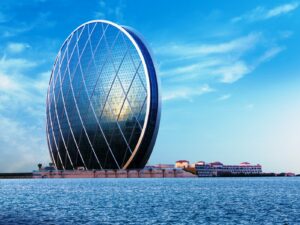 Father of Gazelle. It is thought this name came about because of the abundance of gazelles in the area. Those gazelles have long since been replaced by people – the population has grown in the last 60 years from 25,000 to 1.5 million! And skyscrapers you would not believe. Some of the tallest buildings on the skyline include the 1,253 ft Central Market Residential Tower, the 1,063 ft Landmark, and the 74-story 1,017 ft Sky Tower. And not just tall, but unique, the Aldar Headquarters was the first circular skyscraper in the Middle East. Because of its coin shape, it is called the Dirham building, after the Emirati currency.
Father of Gazelle. It is thought this name came about because of the abundance of gazelles in the area. Those gazelles have long since been replaced by people – the population has grown in the last 60 years from 25,000 to 1.5 million! And skyscrapers you would not believe. Some of the tallest buildings on the skyline include the 1,253 ft Central Market Residential Tower, the 1,063 ft Landmark, and the 74-story 1,017 ft Sky Tower. And not just tall, but unique, the Aldar Headquarters was the first circular skyscraper in the Middle East. Because of its coin shape, it is called the Dirham building, after the Emirati currency.
Abu Dhabi’s rapid development and urbanization, coupled with its massive oil and gas reserves and relatively high average income, have transformed it into a large, developed metropolis. It is the capital and the second-most populous city of the United Arab Emirates (after Dubai), and accounts for about two-thirds of the $400 billion UAE economy. Abu Dhabi sits on an island in the Persian Gulf, though most of the city and the Emirate reside on 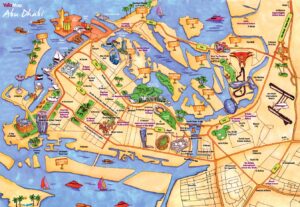 the mainland connected to the rest of the country. I’m one of the lucky ones waking up on the island this morning. My hotel, the Marriott St Regis, is another one of the “tall unusual”
the mainland connected to the rest of the country. I’m one of the lucky ones waking up on the island this morning. My hotel, the Marriott St Regis, is another one of the “tall unusual” 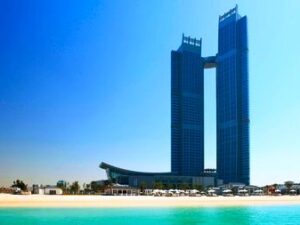 buildings in Abu Dhabi, and I have never been so close to luxury’s lap. See the “connector” between the two towers? That is the 3-bedroom private suite with its own elevator to the 46th floor and a view to die for. That’s not my room, (chuckle, I left my
buildings in Abu Dhabi, and I have never been so close to luxury’s lap. See the “connector” between the two towers? That is the 3-bedroom private suite with its own elevator to the 46th floor and a view to die for. That’s not my room, (chuckle, I left my 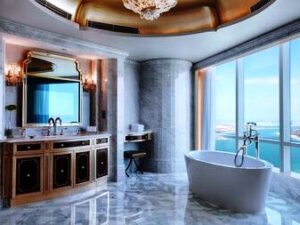 helicopter back home), but my view is pretty darn spectacular, looking out over the Persian Gulf; for pete’s sake, just look at my bathroom!
helicopter back home), but my view is pretty darn spectacular, looking out over the Persian Gulf; for pete’s sake, just look at my bathroom!
I’d stay right here at this hotel all day long, except, I am dying to see the skyscrapers here, and I have to visit the Presidential Palace. It’s just down the street, and as of last year, is open for public visits. It is called “Qaṣr Al-Waṭan” in Arabic, meaning “Palace of the Nation” and is ranked among the top 20 landmarks of art and culture in the world. It could be called “The White House” – its façade is white granite and limestone, intricately designed and ornately decorated. It includes a dome with a diameter of 121 ft, and a  chandelier with 350,000 pieces of crystal. The dome is located on top of the central chamber known as “The Great Hall,” which is surrounded by two wings to the east and west.
chandelier with 350,000 pieces of crystal. The dome is located on top of the central chamber known as “The Great Hall,” which is surrounded by two wings to the east and west.
The eastern wing has the “House of Knowledge,” where a number of artifacts and other objects of importance are stored, such as gifts presented by visiting officials from other countries, religious texts (the Quran and the Bible), and a library with more than 50,000 books which document the cultural, social and political history of the country. The western wing is used for official purposes. Meetings of the UAE Cabinet and Federal Supreme Council, and summits of international bodies like the Organisation of the Islamic Conference, Arab League, and Gulf Cooperation Council are held here in a room known as the “Spirit of Collaboration.”
I’m going to point out just a few more skyscrapers; the Etihad Towers are near the Palace; five towers keeping company, do they look like swaying grass or trees against the skyline to you? Two of the towers are connected by a walkway on the 75th floor.
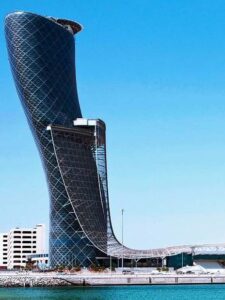 The Capital Gate, just on down the road a way, is referred to as the “Leaning Tower of Abu Dhabi,” and holds the Guinness World Record for the “world’s furthest-leaning man-made tower.” Completed in 2011, it is also the Middle East’s first building to use a material-saving diagrid form.
The Capital Gate, just on down the road a way, is referred to as the “Leaning Tower of Abu Dhabi,” and holds the Guinness World Record for the “world’s furthest-leaning man-made tower.” Completed in 2011, it is also the Middle East’s first building to use a material-saving diagrid form.
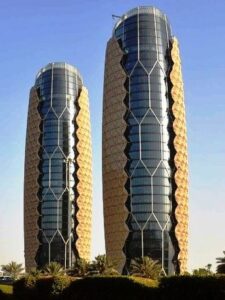 And when it comes to design, look at the twin, 29-story Al Bahr Towers riff on the traditional Arabian mashrabiya (geometric window coverings) as an ingenious energy-saving measure; the windows react automatically to the sun, expanding to provide shade and reduce the need for air conditioning. This one was completed in 2013.
And when it comes to design, look at the twin, 29-story Al Bahr Towers riff on the traditional Arabian mashrabiya (geometric window coverings) as an ingenious energy-saving measure; the windows react automatically to the sun, expanding to provide shade and reduce the need for air conditioning. This one was completed in 2013.
I’ll tell you what I discover about the food, and the other sights I see in a later post. Right now I’m a little dizzy from all that looking up.
» posted on Sunday, August 7th, 2022 by Linda Lou Burton
Checking In On Reality
Originally published August 6, 2020 by Linda Lou Burton posting from Little Rock, Arkansas – A reality check today, before I talk about my wonderful visit to Abu Dhabi.
It is clear, I hope, that all my travel posts are strictly imaginary. Imaginary, however, only due to COVID-19. This was to be a full-fledged Round The World trip celebrating 81 years of life,  and I had booked all the hotels I mention in my posts, and selected all my flights. I carefully routed myself for the shortest in-air time possible, over the least amount of water. I’m not good at sitting in a tube with a belt buckled over my lap for more than six hours! So I meticulously planned.
and I had booked all the hotels I mention in my posts, and selected all my flights. I carefully routed myself for the shortest in-air time possible, over the least amount of water. I’m not good at sitting in a tube with a belt buckled over my lap for more than six hours! So I meticulously planned.
But “life happens while you’re making other plans” fell true this March, when world travel was shut down in a hurry. So I consoled myself by declaring I’d imagine the trip, and think myself there. I renamed it the Now Defunct Imaginary Round The World (NDI RTW), and I started writing. After Abu Dhabi I go to Cairo, and cruise the Nile; then Reykjavik, Iceland, the northernmost capital city in the world! Get it? Wellington, and Reykjavik? My two high-school-graduate grandchildren are (were) meeting me there, and then a flight to Washington, DC together for a rousing end to an RTW, and finally a grand celebration back in Little Rock.
As of this week, the Center for Disease Control reports 4,678,610 cases of COVID-19 in the United States.
The World Health Organization reports 18,614,177 cases of COVID-19 worldwide.
I checked on current travel restrictions in the countries on my RTW, info from the US State Department, the agencies within countries, and the airlines. Here goes:
New Zealand
The New Zealand borders are closed for all but critical travel — protecting public health in New Zealand is paramount. The travel ban applies to all arrivals into New Zealand whether it is by air or sea. To help stop the spread of COVID-19, people who do arrive in New Zealand are required to undergo either managed isolation or quarantine for at least 14 days. https://covid19.govt.nz/travel-and-the-border/border-restrictions/#border-entry-restrictions
Australia
Australia’s borders are closed. Only Australian citizens, residents and immediate family members can travel to Australia. Australian Border Force liaison officers will work with airlines at overseas airports to identify those who should not board flights to Australia. https://www.health.gov.au/news/health-alerts/novel-coronavirus-2019-ncov-health-alert/coronavirus-covid-19-restrictions/coronavirus-covid-19-advice-for-international-travellers#travel-into-australia
Thailand
Updated 01st of August 2020: The Civil Aviation Authority in Thailand decided to extend the restrictions concerning commercial flights arriving in Thailand (with some exceptions) until 31th of August 2020. https://www.thaiairways.com/en_SE/news/news_announcement/news_detail/coronavirus.page
United Arab Emirates
The UAE government announced travelers must have a negative COVID-19 test result before flying to the country. The National Crisis and Emergency Management Authority (NCEMA) said all travelers, including Emiratis, residents, tourists, and transit passengers, must have a negative COVID-19 PCR (nasal swab) test result within 96 hours in order to board commercial flights to the UAE. NCEMA said the new system will be in place August 1. However, there are reports Etihad and Emirates airlines began implementing this new regulation on July 24. https://ae.usembassy.gov/u-s-citizen-services/covid-19-information/
Egypt
As of the evening of August 5, there were 94,875 confirmed cases of Covid-19 and 4,930 deaths in Egypt. Egypt is implementing 14-day quarantine periods and other preventative measures in all cases. https://eg.usembassy.gov/u-s-citizen-services/covid-19-information/
Iceland
As of 31 July, passengers arriving in Iceland who intend to stay in Iceland for 10 days or more have to undergo 2 COVID tests. The first is at the border on arrival and the second by the primary healthcare service 4-6 days later. In between the two tests, special precautions need to be taken. https://www.icelandair.com/support/covid-19/faq
Washington DC
As of July 24, if you are out in DC, you are required to wear a mask, with a few exceptions for vigorous exercise or while you’re actively eating or drinking. A self-quarantine of 14 days is required after participating in non-essential travel to/from high-risk areas when returning or traveling to Washington, DC, beginning July 27. The list of high-risk states included in the Mayor’s order are below and are in effect until Monday, Aug. 10.
- Arkansas
- Arizona
- Alabama
- California
- Delaware
- Florida
- Georgia
- Idaho
- Iowa
- Kansas
- Louisiana
- Mississippi
- Missouri
- Montana
- Nebraska
- Nevada
- New Mexico
- North Carolina
- North Dakota
- Ohio
- Oklahoma
- South Carolina
- Tennessee
- Texas
- Utah
- Washington
- Wisconsin
There you have it.
» posted on Saturday, August 6th, 2022 by Linda Lou Burton
Old Time Religion
Originally published August 5, 2020 by Linda Lou Burton posting about Abu Dhabi, United Arab Emirates from Little Rock, Arkansas – Today is moving day – I leave Bangkok to go to Abu Dhabi, capital of United Arab Emirates. My 3,100-mile Ethiad Airlines flight takes me over the tip of Myanmar, the Bay of Bengal, the widest part of India, and the Arabian Sea before a plane change in Muscat, Oman’s capital city.  I arrive at the Abu Dhabi International Airport (AUH) at 3:05 and head for the Marriott St Regis where my room overlooks the Persian Gulf. And I exchange a view of golden stupas for white domed mosques. It was an adjustment coming to Bangkok, a city where there are more people per square mile than I’ve ever experienced, but I had friends from Thailand; I knew the people, and loved the food, even if I didn’t speak the language. I have never met a single person from the UAE; I don’t know the language, and I have no idea as to what to expect in this Middle Eastern country. That is why I chose to visit. I have a lot to learn. Where to start?
I arrive at the Abu Dhabi International Airport (AUH) at 3:05 and head for the Marriott St Regis where my room overlooks the Persian Gulf. And I exchange a view of golden stupas for white domed mosques. It was an adjustment coming to Bangkok, a city where there are more people per square mile than I’ve ever experienced, but I had friends from Thailand; I knew the people, and loved the food, even if I didn’t speak the language. I have never met a single person from the UAE; I don’t know the language, and I have no idea as to what to expect in this Middle Eastern country. That is why I chose to visit. I have a lot to learn. Where to start?
Waking up this morning in Bangkok, a city filled with Buddhist temples (wats) and going to sleep tonight in Abu Dhabi, a city filled with Islamic mosques, got me thinking about religion. Religions need “places to worship and practice,” hence, belief systems impact architecture; and so, it follows, the “look” of a country. I already understand the basic design features and symbols standard to Christian churches and cathedrals. But I don’t know why wats and mosques look the way they do. So I read about them; listen up.
Architecture of a Wat
The Sangkhawat contains the monks’ living quarters and lies within the wall surrounding the temple compound. The Phutthawat is the area dedicated to Buddha and contains several buildings.
 Ho rakhang, a bell tower used for waking the monks and announcing morning and evening ceremonies
Ho rakhang, a bell tower used for waking the monks and announcing morning and evening ceremonies- Chedi or Stupa in the form of a bell-shaped tower covered with gold leaf, containing a relic chamber
- Ubosot or Bot, the ordination hall and most sacred area
- Wihan, a shrine hall that contains the principal Buddha images and where monks and laypeople congregate
- Sala kan parian, a large, open hall where laity can hear sermons or receive religious education, also used for chanting afternoon prayers
- Sala, an open pavilion providing shade and a place to rest
- Phra rabiang, a peristyle built around the sacred inner area as a cloister
- Ho trai, the temple library or sacred scriptures depository
- Ancillary buildings such as a school
Certain symbols allude to different aspects of the Buddhist religion. One is the four-armed figure of Vishnu; another is the Naga, deities which may appear as a snake, dragon or cobra.
The Wat Pho in Bangkok
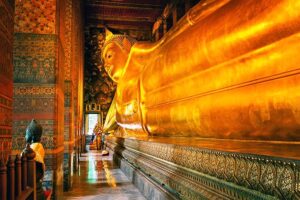 Wat Pho is one of the largest wats in Bangkok. covering over 860,000 square feet. It is home to more than one thousand Buddha images, as well as one of the largest, the Reclining Buddha, 151 feet in length. The perimeter wall has sixteen gates, two of which serve as entrances for the public. The grounds contain four great chedis, 91 small chedis, two belfries, a bot (central shrine), a number of viharas (halls) and various buildings such as pavilions, as well as gardens and a small temple museum. Wat Pho is also a place of education for the general public. A pictorial encyclopedia engraved on granite slabs covers eight subject areas: history, medicine, health, custom, literature, proverbs, lexicography, and the Buddhist religion.
Wat Pho is one of the largest wats in Bangkok. covering over 860,000 square feet. It is home to more than one thousand Buddha images, as well as one of the largest, the Reclining Buddha, 151 feet in length. The perimeter wall has sixteen gates, two of which serve as entrances for the public. The grounds contain four great chedis, 91 small chedis, two belfries, a bot (central shrine), a number of viharas (halls) and various buildings such as pavilions, as well as gardens and a small temple museum. Wat Pho is also a place of education for the general public. A pictorial encyclopedia engraved on granite slabs covers eight subject areas: history, medicine, health, custom, literature, proverbs, lexicography, and the Buddhist religion.
Architecture of a Mosque
Most mosques feature one or more domes, called qubba. Because it is the directional focus of prayer, the qibla wall is often the most ornately decorated area of a mosque.
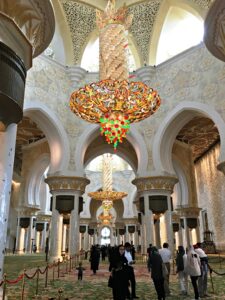 Minaret, a tall, slender tower at corners of the mosque, worshippers are called to prayer from here, it is often the highest point in the area
Minaret, a tall, slender tower at corners of the mosque, worshippers are called to prayer from here, it is often the highest point in the area- Mehrab, a semicircular niche in the wall of a mosque that indicates the direction of the Kaaba in Mecca, the direction that Muslims should face when praying
- Domes above the main prayer hall, signifying the vaults of the heaven and sky
- Prayer hall, with no chairs or pews so as many worshipers as possible can line the room
- Raised areas from which daily prayers are led, or sermons delivered
- Ablution areas where Muslims wash hands, forearm, face and feet before they pray
- Additional facilities from health clinics to libraries to gymnasiums, to serve the community
Certain symbols allude to different aspects of the Islamic religion. One of these is the spiral in reference to heaven as it has “no beginning and no end.” Mosques often have floral patterns or images of fruit and vegetables, allusions to paradise after death.
The Grand Mosque in Abu Dhabi
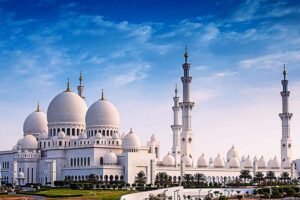 The Grand Mosque in Abu Dhabi is the largest in the country, accommodating over 40,000 worshippers; the main prayer hall can hold over 7,000. There are two smaller prayer halls, with a capacity of 1,500 each, one of which is the women’s prayer hall. Minarets on the four corners of the courtyard are 351 feet in height. The courtyard is 180,000 square feet; its floral design is considered to be the largest example of marble mosaic in the world. The carpet in the main prayer hall measures 60,570 square feet, weighs 35 tons, and was made by 1,300 carpet knotters. The pools along the arcades reflect the mosque’s columns, which are illuminated at night; the lighting system reflects the phases of the moon. The 96 columns in the main prayer hall are marble clad and inlaid with mother of pearl. The 99 qualities or attributes of God (Allah) are featured on the qibla wall in traditional Kufic calligraphy.
The Grand Mosque in Abu Dhabi is the largest in the country, accommodating over 40,000 worshippers; the main prayer hall can hold over 7,000. There are two smaller prayer halls, with a capacity of 1,500 each, one of which is the women’s prayer hall. Minarets on the four corners of the courtyard are 351 feet in height. The courtyard is 180,000 square feet; its floral design is considered to be the largest example of marble mosaic in the world. The carpet in the main prayer hall measures 60,570 square feet, weighs 35 tons, and was made by 1,300 carpet knotters. The pools along the arcades reflect the mosque’s columns, which are illuminated at night; the lighting system reflects the phases of the moon. The 96 columns in the main prayer hall are marble clad and inlaid with mother of pearl. The 99 qualities or attributes of God (Allah) are featured on the qibla wall in traditional Kufic calligraphy.
It seems there’s not much difference in wats and mosques, when you think about what they mean to the people who built them.
» posted on Friday, August 5th, 2022 by Linda Lou Burton
Room With A View
Originally published August 4, 2020 by Linda Lou Burton posting about Bangkok, Thailand from Little Rock, Arkansas – “We were promised rooms with a view of the Arno!” Miss Charlotte fusses, frowning at the ordinary street scene just out the window. Remember the movie Room With a View? Lucy Honeychurch (Helena Bonham Carter) and her spinster chaperone Miss Charlotte (Maggie Smith) enter their hotel room in Florence only to discover they’ve been misassigned. The plot of the movie hinges on that moment, though Miss Lucy claimed the view didn’t matter. Maggie Smith’s chin was set in that Maggie Smith way, insisting that it did most certainly matter; “It’s your first impression of Italy!”
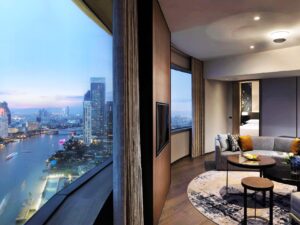 I’m with Miss Charlotte on that point. It matters. All my hotel bookings for the NDI RTW ranked “view” over “cost” in every instance. A view right into Kilauea crater in Hawaii. A view over the harbor in Wellington. A view across the desert to the big red rock in Uluru. A view across the beach to the Indian Ocean in Perth. I like to go to sleep and wake up with priceless images chunking themselves into my memory bank. Store them for later, like maybe when I’m mopping the kitchen floor. Been THERE, my brain reminds me, calling up a visual of the Sahara. Done THAT. This morning, my memory bank is loading up, because Bangkok and the Chao Phraya are just beyond the blink of my eye. Look at what I get to see before I even get out of my pajamas! A panoramic view, as promised.
I’m with Miss Charlotte on that point. It matters. All my hotel bookings for the NDI RTW ranked “view” over “cost” in every instance. A view right into Kilauea crater in Hawaii. A view over the harbor in Wellington. A view across the desert to the big red rock in Uluru. A view across the beach to the Indian Ocean in Perth. I like to go to sleep and wake up with priceless images chunking themselves into my memory bank. Store them for later, like maybe when I’m mopping the kitchen floor. Been THERE, my brain reminds me, calling up a visual of the Sahara. Done THAT. This morning, my memory bank is loading up, because Bangkok and the Chao Phraya are just beyond the blink of my eye. Look at what I get to see before I even get out of my pajamas! A panoramic view, as promised.
This hotel has 533 rooms and a lounge named “360” on the very top of it, so “a view” is there to be had in every direction, all of the time. Just last night I made a late-call on that rooftop 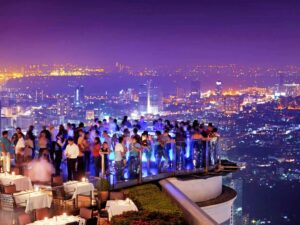 lounge. There is also a rooftop bar “in the open” here, and, I note, there seems to be a competition in Bangkok for the highest space and the widest view. One high-rise bar is named Vertigo!
lounge. There is also a rooftop bar “in the open” here, and, I note, there seems to be a competition in Bangkok for the highest space and the widest view. One high-rise bar is named Vertigo!
But a view doesn’t have to be expansive to be memorable. Some of the best sights are up close and personal, like the view from a longtail boat as you glide through the city’s narrow canals, or klongs. That is your new Thai word for today – klongs.
At One Time It Was Called Venice
 Klong means “canal” and there are 1,682 of them in Bangkok, covering about 1,600 miles. At one time Bangkok had the nickname, “Venice of the East.” Klongs were used for transportation, for floating markets, and yes, for sewage disposal. Today, most of the klongs of Bangkok have been filled in, although the Thonburi side of Bangkok, covering areas west of Chao Phraya River, still retains several of its larger klongs. Klong Saen Saep in central Bangkok is a significant thoroughfare in Bangkok’s public transportation network. The Thai word “klong” is not limited to artificial canals, by the way; many small rivers are referred to as “klongs,” followed by the name of the stream.
Klong means “canal” and there are 1,682 of them in Bangkok, covering about 1,600 miles. At one time Bangkok had the nickname, “Venice of the East.” Klongs were used for transportation, for floating markets, and yes, for sewage disposal. Today, most of the klongs of Bangkok have been filled in, although the Thonburi side of Bangkok, covering areas west of Chao Phraya River, still retains several of its larger klongs. Klong Saen Saep in central Bangkok is a significant thoroughfare in Bangkok’s public transportation network. The Thai word “klong” is not limited to artificial canals, by the way; many small rivers are referred to as “klongs,” followed by the name of the stream.
I Promised I Wouldn’t Talk About Congestion, but
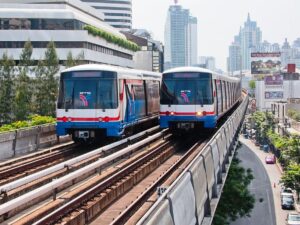 Even with its many lovely options for water transportation, Bangkok suffers the problems any city has when there are too many cars and not enough roads. Great effort has been made to remedy that with the Bangkok Mass Transit System, commonly known as the BTS or the Skytrain. This elevated system consists of 52 stations along two lines with a combined route length of 33 miles. Bangkok’s rapid transit system also includes the underground and elevated Mass Rapid Transit (MRT) railway lines, the Bus Rapid Transit System (BRT), and the elevated Airport Rail Link (ARL), serving several stations in the city before reaching Suvarnabhumi Airport.
Even with its many lovely options for water transportation, Bangkok suffers the problems any city has when there are too many cars and not enough roads. Great effort has been made to remedy that with the Bangkok Mass Transit System, commonly known as the BTS or the Skytrain. This elevated system consists of 52 stations along two lines with a combined route length of 33 miles. Bangkok’s rapid transit system also includes the underground and elevated Mass Rapid Transit (MRT) railway lines, the Bus Rapid Transit System (BRT), and the elevated Airport Rail Link (ARL), serving several stations in the city before reaching Suvarnabhumi Airport.
Just think, it may be fast-moving, but a ride on an elevated train is an excellent way to see a large city such as Bangkok. Thirty-three miles of looking out your window at a “changing by the second” view.
Lots of images to store in the old memory bank.
» posted on Thursday, August 4th, 2022 by Linda Lou Burton
Good Things Come in Threes
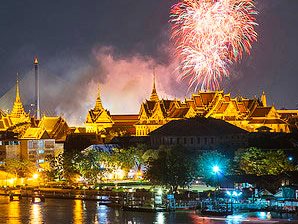 Originally Published August 3, 2020 by Linda Lou Burton posting about Bangkok, Thailand from Little Rock, Arkansas – “Bangkok is as intoxicating as it is diverse; a melting pot of exotic aromas, interesting sights and visual delights. It is a city with infinite layers to explore.” That’s the message on the Hotel.com website, which then presents a splendid list of Things To Do in Bangkok; the choices offered put me in mind of Twelve Days of Christmas, hum that tune as you read and you’ll see what I mean!
Originally Published August 3, 2020 by Linda Lou Burton posting about Bangkok, Thailand from Little Rock, Arkansas – “Bangkok is as intoxicating as it is diverse; a melting pot of exotic aromas, interesting sights and visual delights. It is a city with infinite layers to explore.” That’s the message on the Hotel.com website, which then presents a splendid list of Things To Do in Bangkok; the choices offered put me in mind of Twelve Days of Christmas, hum that tune as you read and you’ll see what I mean!
- 2 Days In All
- 6 Floating Markets
- 7 Things in Chinatown
- 9 Things in Old Town
- 10 Best Tours
- 11 Best Thai Restaurants
- 12 Night Markets
- 20 Must See Temples
- 21 Rooftop Bars
- 67 Best Things
I clicked on the 67 Best link (wondering how 67 things can all be Best and thinking it should be Great instead) and read about everything from the Grand Palace to a Crocodile Farm, making special note of 11 Best (Great? Top-Notch?) Thai Restaurants. My own hotel is one of the 21 Rooftop Bars so I’m set there. I decided that #1 of the 67 really is Best, here in the “hottest capital city in the world.” You know I’d pick the Palace first.
The Grand Palace, #1
 The dazzling Grand Palace is the most famous landmark in Bangkok. It was built in 1782 and for 150 years was home of the Thai King, the Royal court and the administrative seat of government. Within its walls were also the Thai war ministry, state departments, and even the mint. Today, the complex remains the spiritual heart of the Thai Kingdom. Within the palace complex is also Wat Phra Kaew (Temple of the Emerald Buddha), which contains the greatly revered Emerald Buddha that dates back to the 14th century. The Grand Palace, with the Temple of the Emerald Buddha, is Thailand’s most sacred site. Visitors must be properly dressed before entering the temple.
The dazzling Grand Palace is the most famous landmark in Bangkok. It was built in 1782 and for 150 years was home of the Thai King, the Royal court and the administrative seat of government. Within its walls were also the Thai war ministry, state departments, and even the mint. Today, the complex remains the spiritual heart of the Thai Kingdom. Within the palace complex is also Wat Phra Kaew (Temple of the Emerald Buddha), which contains the greatly revered Emerald Buddha that dates back to the 14th century. The Grand Palace, with the Temple of the Emerald Buddha, is Thailand’s most sacred site. Visitors must be properly dressed before entering the temple.
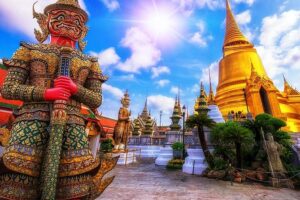 There were a few words I had to get the hang of before I began touring. I learned that “Wat” is a temple. “Stupa” is a bell-shaped tower containing a relic chamber. “Wihan” is a shrine hall that contains the principal Buddha images. Not knowing all the words doesn’t detract from the beauty of the temples, or dampen my appreciation for what they mean to those who worship there, but it’s nice to make a connection, as I did when visiting the mosques in Morocco last year, or standing in the shadow of Uluru a few days ago.
There were a few words I had to get the hang of before I began touring. I learned that “Wat” is a temple. “Stupa” is a bell-shaped tower containing a relic chamber. “Wihan” is a shrine hall that contains the principal Buddha images. Not knowing all the words doesn’t detract from the beauty of the temples, or dampen my appreciation for what they mean to those who worship there, but it’s nice to make a connection, as I did when visiting the mosques in Morocco last year, or standing in the shadow of Uluru a few days ago.
 So let’s review: a wat is a temple; a stupa is a bell-shaped tower, and a wihan is a shrine hall containing Buddha images. Got it? Can you pick out the stupas?
So let’s review: a wat is a temple; a stupa is a bell-shaped tower, and a wihan is a shrine hall containing Buddha images. Got it? Can you pick out the stupas?
Wat Arun. Wat Benchamabophit. Wat Phra. Wat Saket. As I read about these sacred places, which attract tourists because of their architecture and beauty, I tried to narrow my visits to just one more. But how to choose? If you can’t do it all, Hotel.com suggests a sunset dinner cruise to see the temples along the river; Wat Arun looks magical, illuminated against the night sky.
Chao Phraya: The River of Kings, #2
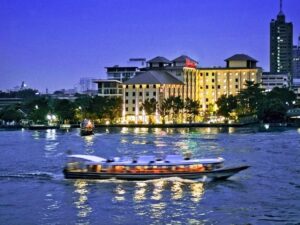 You know I love rivers. My hotel room overlooks this river, and has restaurants beside this river. I will get on this river, likely in several different ways. There are ferries and tour boats and longtail boats that even go to the canals. This river, named by King Rama I, is the lifeblood of Bangkok. Around 50,000 people use the ferries to get around each day. Slow cargo barges coast upstream. Kids frolic in the russet-brown water. Wooden shacks lurch over the riverbanks. Soaring hotels hem in solemn temples. Wooden sampans sell noodle soup to hungry river workers. It is calm and chaotic, modern and traditional, religious and secular, ugly and sublime, foreign and indigenous. I will enjoy the Chao Phraya every day I’m in Bangkok.
You know I love rivers. My hotel room overlooks this river, and has restaurants beside this river. I will get on this river, likely in several different ways. There are ferries and tour boats and longtail boats that even go to the canals. This river, named by King Rama I, is the lifeblood of Bangkok. Around 50,000 people use the ferries to get around each day. Slow cargo barges coast upstream. Kids frolic in the russet-brown water. Wooden shacks lurch over the riverbanks. Soaring hotels hem in solemn temples. Wooden sampans sell noodle soup to hungry river workers. It is calm and chaotic, modern and traditional, religious and secular, ugly and sublime, foreign and indigenous. I will enjoy the Chao Phraya every day I’m in Bangkok.
Siam Niramit, #3
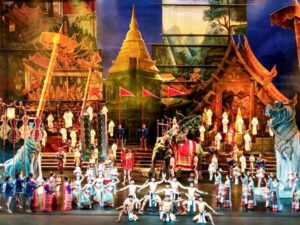 Billed as one of the largest stage productions in the world, Siam Niramit brings back the glorious past of Thailand with a spectacular 90-minute show. The colossal 2,000-seat Ratchada Theatre’s stage occupies more than half the theater space, built to accommodate the show’s monumental set pieces and a legion of performers, including real elephants and goats, recreating the ambience of Siam. The show covers 700 years of Thai history, structured in 3 acts: Journey Back into History, Journey Beyond Imagination: The Three Realms, and Journey Through Joyous Festivals. The Siam Niramit compound houses the theater, a miniature Thai village, and a restaurant; it’s decked in contemporary Thai style with small salas (gazebos); you can also feed the elephants!
Billed as one of the largest stage productions in the world, Siam Niramit brings back the glorious past of Thailand with a spectacular 90-minute show. The colossal 2,000-seat Ratchada Theatre’s stage occupies more than half the theater space, built to accommodate the show’s monumental set pieces and a legion of performers, including real elephants and goats, recreating the ambience of Siam. The show covers 700 years of Thai history, structured in 3 acts: Journey Back into History, Journey Beyond Imagination: The Three Realms, and Journey Through Joyous Festivals. The Siam Niramit compound houses the theater, a miniature Thai village, and a restaurant; it’s decked in contemporary Thai style with small salas (gazebos); you can also feed the elephants!
Those are my Top Three choices. I will never make it to 67.
PS Those 11 Best Thai Restaurants? More numbers.
- Baan Home Cuisine, real Thai family cooking, Chef Ton brought recipes from his childhood, traditional ingredients and cuisine.
- Bo.Lan Restaurant, recognized for many years as one of the best Thai restaurants in Bangkok, not your everyday local eatery.
- Issaya Siamese Club is a 100-year-old house in the middle of a luscious green garden; exceptional service and the culinary flair of Chef Ian Kittichai.
- Long Table, for appetizers 5 deep-fried tiger prawns lined up in a row, served on a fried betel leaf, with crispy, browned lemongrass sprinkled on top, distinctly Thai.
- Nahm Restaurant, Thai cuisine prepared according to ancient recipes, a Michelin-star chef.
- Saffron at Banyan Tree, high above the city on the 52nd floor of the Banyan Tree Hotel, fantastic views, delicious food.
- Sala Rim Naam at the Mandarin Oriental, amazing riverside location, legendary Mandarin Oriental service, truly great food.
- Steve Café and Cuisine, riverside location with no tall buildings blocking the view, old-fashioned wooden boats passing by, very Thai food, quality ingredients.
- Supanniga Eating Room, an old shophouse with outside terrace, owner Eh serves traditional Thai dishes from his grandmother’s recipes.
- Thanying Royal Cuisine, fresh ingredients, elegant presentation, set in a charming classic house with a small shaded terrace on the side.
- The House Of Smooth Curry, traditional Thai dishes, service and food quality are 5-star but the atmosphere is unstuffy.
Can you possibly pick just three?
» posted on Wednesday, August 3rd, 2022 by Linda Lou Burton
Number Seven
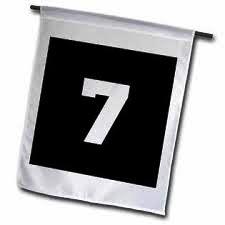 Originally Published August 2, 2020 by Linda Lou Burton posting about Bangkok, Thailand from Little Rock, Arkansas – When I stepped off the plane at Bangkok’s airport yesterday, there should have been fireworks or marching bands. At the least I should have waved a little flag with Number 7 on it. Because, drum roll here, I was finally on Continent Number Seven! I was in my 60s before I ventured out of North America, with my trip to Antarctica via South America. And in my 80s when I got to Europe and Africa last year. Don’t wait that long to see the world! The world is a book and those who do not travel read only a page, Saint Augustine said a very long time ago. Travel is an eye-opener; it takes you out of yourself, I believe, and gives you more space for living your life. So, as soon as the lid on travel due to COVID-19 is lifted, get out and go. Meanwhile, it doesn’t hurt to imagine, and to learn about the rest of the world, as I am doing with my NDI RTW.
Originally Published August 2, 2020 by Linda Lou Burton posting about Bangkok, Thailand from Little Rock, Arkansas – When I stepped off the plane at Bangkok’s airport yesterday, there should have been fireworks or marching bands. At the least I should have waved a little flag with Number 7 on it. Because, drum roll here, I was finally on Continent Number Seven! I was in my 60s before I ventured out of North America, with my trip to Antarctica via South America. And in my 80s when I got to Europe and Africa last year. Don’t wait that long to see the world! The world is a book and those who do not travel read only a page, Saint Augustine said a very long time ago. Travel is an eye-opener; it takes you out of yourself, I believe, and gives you more space for living your life. So, as soon as the lid on travel due to COVID-19 is lifted, get out and go. Meanwhile, it doesn’t hurt to imagine, and to learn about the rest of the world, as I am doing with my NDI RTW.
I was curious as to where in the world most travelers do tend to go and found a map based on data collected by the United Nations World Tourism Organization (UNWTO). It doesn’t show Antarctica numbers; when I was there in 2005 it was estimated that only 250,000 people had ever set foot there. People fly over it, from New Zealand and Australia in particular. And every year in recent times about 14,000 people get there on a cruise ship. But restrictions only allow 100 people to go ashore at any one time, so I’d say far less than half a million people have ever walked on Antarctic soil.
As you can see from the map, most tourists head for Europe or the US, but Asia racks up big numbers too, especially China. And Thailand! Especially Bangkok. In 2019, Bangkok ranked 1st (surpassing Paris and London) in Mastercard’s list of “Global Destination Cities” with over 22 million visitors annually. https://ourworldindata.org/tourism
So let’s focus on that chunk of the world for today.
Asia
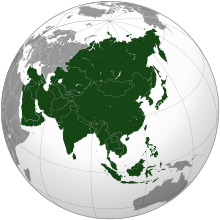 Asia is Earth’s largest and most populous continent, though it is a bit hard to define, as it shares the landmass of Eurasia with Europe, and the landmass of Afro-Eurasia with both Europe and Africa. But within politically drawn lines are about 17+ million square miles and roughly 4.5 billion people. Within those square miles is an expansive range of climates – the equatorial south, the subarctic and polar areas in Siberia, hot deserts in the Middle East, and a temperate center. And those 4.5 billion people represent an enormous variety of ethnic groups, cultures, environments, economics, historical ties and government systems. And don’t forget – Asia was the birthplace of the world’s mainstream religions: Buddhism, Christianity, Confucianism, Hinduism, Islam, Judaism, as well as many other religions.
Asia is Earth’s largest and most populous continent, though it is a bit hard to define, as it shares the landmass of Eurasia with Europe, and the landmass of Afro-Eurasia with both Europe and Africa. But within politically drawn lines are about 17+ million square miles and roughly 4.5 billion people. Within those square miles is an expansive range of climates – the equatorial south, the subarctic and polar areas in Siberia, hot deserts in the Middle East, and a temperate center. And those 4.5 billion people represent an enormous variety of ethnic groups, cultures, environments, economics, historical ties and government systems. And don’t forget – Asia was the birthplace of the world’s mainstream religions: Buddhism, Christianity, Confucianism, Hinduism, Islam, Judaism, as well as many other religions.
There are 49 countries in Asia. Thailand is the talk today.
Thailand
 Thailand is the 14th largest country by area in Asia, with 198,000 square miles divided into 76 provinces where 66 million people live. Once called Siam, it is bordered by Myanmar (once called Burma), Laos, Cambodia, Malaysia, the Gulf of Thailand, and the Andaman Sea.
Thailand is the 14th largest country by area in Asia, with 198,000 square miles divided into 76 provinces where 66 million people live. Once called Siam, it is bordered by Myanmar (once called Burma), Laos, Cambodia, Malaysia, the Gulf of Thailand, and the Andaman Sea.
Thailand is a constitutional monarchy and parliamentary democracy; however, in recent history, its government has experienced multiple coups and periods of military dictatorships. After WWII Thailand became a major ally of the United States, periodically alternating between democracy and military rule. The most recent coup in 2014 established its current and 20th constitution. Despite sporadic changes in leadership, Thailand has a high level of human development. Its manufacturing, agriculture, and tourism make it the 20th-largest economy in the world. The capital and largest city is Bangkok, a special administrative area.
Bangkok
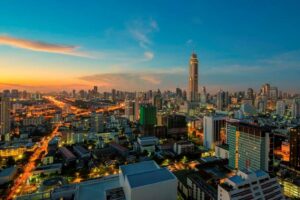 Over 8 million people live in Bangkok; 14 million in the surrounding metro area. The city covers 606 square miles in the Chao Phraya River delta in central Thailand. It began as a small trading post during the Ayutthaya Kingdom in the 15th century; today it is a regional force in finance and business. It is an international hub for transport and health care and is a center for the arts, fashion, and entertainment. It is known for its street life and cultural landmarks; also its red-light districts. Rapid growth and little urban planning have resulted in a haphazard cityscape and inadequate infrastructure. Too few roads and too many private cars have caused crippling traffic congestion and severe air pollution. The development of public transportation is attempting to solve the problem, but congestion is still an issue.
Over 8 million people live in Bangkok; 14 million in the surrounding metro area. The city covers 606 square miles in the Chao Phraya River delta in central Thailand. It began as a small trading post during the Ayutthaya Kingdom in the 15th century; today it is a regional force in finance and business. It is an international hub for transport and health care and is a center for the arts, fashion, and entertainment. It is known for its street life and cultural landmarks; also its red-light districts. Rapid growth and little urban planning have resulted in a haphazard cityscape and inadequate infrastructure. Too few roads and too many private cars have caused crippling traffic congestion and severe air pollution. The development of public transportation is attempting to solve the problem, but congestion is still an issue.
The Fun Stuff
Next post I’ll concentrate on the beautiful things I see in Bangkok, not a word about congestion, I promise! We’ll visit the temples, palaces, museums, and parks, and maybe, though I am not a shopper, some of the famous markets, such as Chatuchak Weekend Market, Sampeng Market, Yaowarat, and Phahurat night market.
Life on Number Seven awaits.
https://www.tourismthailand.org/Destinations/Provinces/Bangkok/219
» posted on Tuesday, August 2nd, 2022 by Linda Lou Burton
Pad Thai Tonight
Originally Published August 1, 2020 by Linda Lou Burton posting about Bangkok, Thailand from Little Rock, Arkansas – Big changes afoot. Today I leave things familiar and plunge into things unknown. At least, less 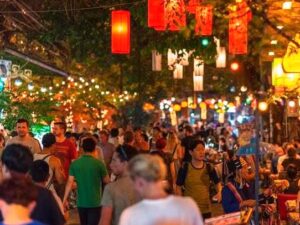 familiar, because so far everywhere I’ve been on the NDI RTW has had “the British touch.” Today I move from the Southern Hemisphere to the Northern; winter to summer; a large county to a small one. The pace changes from easy-going to teeming; more activity, noise, and more people. Australia’s population density is 8. Thailand’s is 348.
familiar, because so far everywhere I’ve been on the NDI RTW has had “the British touch.” Today I move from the Southern Hemisphere to the Northern; winter to summer; a large county to a small one. The pace changes from easy-going to teeming; more activity, noise, and more people. Australia’s population density is 8. Thailand’s is 348.
The change begins at 9:20 this morning when I board Thai Airlines at Perth International Airport (PER). Then a direct flight to Bangkok, traveling 3,316 miles over the Indian Ocean, Indonesia, the Equator, Singapore, and the Gulf of Thailand before setting down at Bangkok’s Suvarnabhumi Airport (BKK) at 3:20 this afternoon. Bangkok is latitudinally in line with Guatemala and Honduras in Central America so I’d expect hot and humid since it’s August, but the temp today is only 89, with light rain.
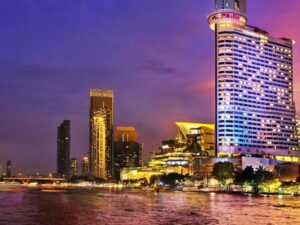 The airport is 37 miles from my hotel in downtown Bangkok, so I made specific arrangements in advance for transportation, no hailing down a last-minute cab for me. I’m booked at Bangkok’s Millennium Hilton, 123 Charoennakorn Road, overlooking the Chao Phraya River. Their blurb states it “offers breathtaking views of the city from every one of its 533 rooms.” I chose a panoramic executive suite, a cowardly move in case I’m so overwhelmed with all the differences I’ll face I can just stare at the city from up high.
The airport is 37 miles from my hotel in downtown Bangkok, so I made specific arrangements in advance for transportation, no hailing down a last-minute cab for me. I’m booked at Bangkok’s Millennium Hilton, 123 Charoennakorn Road, overlooking the Chao Phraya River. Their blurb states it “offers breathtaking views of the city from every one of its 533 rooms.” I chose a panoramic executive suite, a cowardly move in case I’m so overwhelmed with all the differences I’ll face I can just stare at the city from up high.
 I won’t even need to leave the hotel to eat, look at what they say about their dining facilities: Millennium Hilton Bangkok’s contemporary and cutting-edge style extends to its range of dining options all complemented by expansive views of the river, making the hotel’s award-winning restaurants and bars a preferred destination. With a wide range of seven food and beverage outlets to choose from, FLOW, Prime, Yuan, ThreeSixty Jazz Lounge, ThreeSixty Rooftop Bar, The Lantern, and The Beach each offer their distinctive take on local or international dishes and cocktails to suit every palate, in beautiful indoor and outdoor settings.
I won’t even need to leave the hotel to eat, look at what they say about their dining facilities: Millennium Hilton Bangkok’s contemporary and cutting-edge style extends to its range of dining options all complemented by expansive views of the river, making the hotel’s award-winning restaurants and bars a preferred destination. With a wide range of seven food and beverage outlets to choose from, FLOW, Prime, Yuan, ThreeSixty Jazz Lounge, ThreeSixty Rooftop Bar, The Lantern, and The Beach each offer their distinctive take on local or international dishes and cocktails to suit every palate, in beautiful indoor and outdoor settings.
Why have I come to Bangkok in the first place, if it seems so hard to tackle? For one, it is on my Ten Superlative World Capital Cities list. Wellington is the “southernmost capital city in the world;” Bangkok has the “hottest climate.” On average, over a year, with all the climatological record keeping, of course.
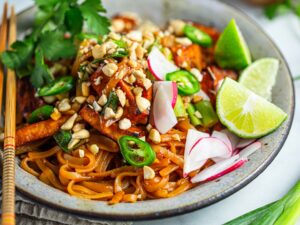 But there is another reason I’ve come to Bangkok. I absolutely, positively, without apology, LOVE Pad Thai, the national food of Thailand. It doesn’t matter if you spell it Pad Thai or Phad Thai or Phat thai or whether you add chicken or shrimp or crab or use fish paste or soy sauce or even what degree of hotness you choose, it is simply good. It made #5 on a list of “World’s 50 Most Delicious Foods” in a CNN readers’ poll a few years back, and it has been on my list since I first tasted it in Seattle in the 1980s. I worked with many people from Thailand at the University of Washington, and our department was notorious for potlucks. Not only did I eat lovingly-home-cooked Pad Thai; the substantial Thai population in Seattle also meant good restaurants. I was hooked on Thai food.
But there is another reason I’ve come to Bangkok. I absolutely, positively, without apology, LOVE Pad Thai, the national food of Thailand. It doesn’t matter if you spell it Pad Thai or Phad Thai or Phat thai or whether you add chicken or shrimp or crab or use fish paste or soy sauce or even what degree of hotness you choose, it is simply good. It made #5 on a list of “World’s 50 Most Delicious Foods” in a CNN readers’ poll a few years back, and it has been on my list since I first tasted it in Seattle in the 1980s. I worked with many people from Thailand at the University of Washington, and our department was notorious for potlucks. Not only did I eat lovingly-home-cooked Pad Thai; the substantial Thai population in Seattle also meant good restaurants. I was hooked on Thai food.
But it wasn’t just Thai food I came to love, it was Thai people. I made so many friends over the years; heard so many stories of Thailand; was issued so many invitations to come and visit – Bangkok, Chiang Mai, the whole country. Everywhere in my house are gifts and mementos given to me in kindness – the elephant bracelet, the delicate silk purse, the embroidered wall 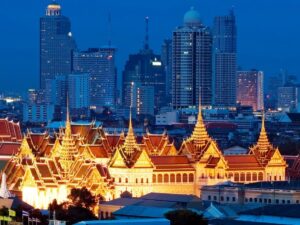 hanging showing mountain people gathered by the fire; the tiny rose intricately carved in scented soap by a friend’s mother.
hanging showing mountain people gathered by the fire; the tiny rose intricately carved in scented soap by a friend’s mother.
So even though the architecture may be different, and the language (and long, long words) may be different, and the fast pace of traffic and honking horns and politics and life in general may scare the liver out of me, I will not stay in my hotel room for four days. I will explore this city, and talk with everyone who will talk with me (in English!). I will love it. And I will eat a lot of Pad Thai.
In Case You Don’t Know What Pad Thai Is
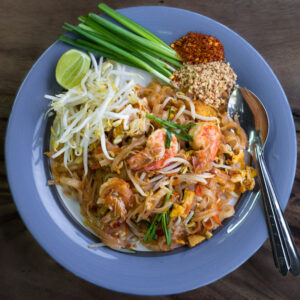 Rice noodles stir fried with eggs and chopped firm tofu, flavored with tamarind pulp, fish sauce, dried shrimp, garlic or shallots, red chili pepper and palm sugar; served with lime wedges and chopped roasted peanuts. It may contain bean sprouts, garlic chives, pickled radishes, turnips, and raw banana flowers; also shrimp, crab, squid, chicken or other animal proteins of choice. Often ingredients are on the side as condiments, such as the red chili pepper, lime wedges, roasted peanuts, bean sprouts, spring onion and other fresh vegetables. Vegetarian versions substitute soy sauce for the fish sauce.
Rice noodles stir fried with eggs and chopped firm tofu, flavored with tamarind pulp, fish sauce, dried shrimp, garlic or shallots, red chili pepper and palm sugar; served with lime wedges and chopped roasted peanuts. It may contain bean sprouts, garlic chives, pickled radishes, turnips, and raw banana flowers; also shrimp, crab, squid, chicken or other animal proteins of choice. Often ingredients are on the side as condiments, such as the red chili pepper, lime wedges, roasted peanuts, bean sprouts, spring onion and other fresh vegetables. Vegetarian versions substitute soy sauce for the fish sauce.
Pad Thai Is Not An Ancient Dish
Stories vary about how this national favorite came to be; I cannot verify but share two of them with you. They sound political, but no matter how the recipe evolved, people everywhere have come to love it!
Pad Thai was created in the 1930s in Thailand by Plaek Phibunsongkhram, the Prime Minister. Thailand was focused on nation building at the time so this dish using Chinese noodles was a way to galvanize nationalism. OR. During World War II, Thailand suffered a rice shortage due to the war and floods. To reduce domestic rice consumption, Prime Minister Phibunsongkhram promoted consumption of noodles instead. The original recipe did not contain pork because of the perception that pork was a Chinese meat.
Believe it, or not.

